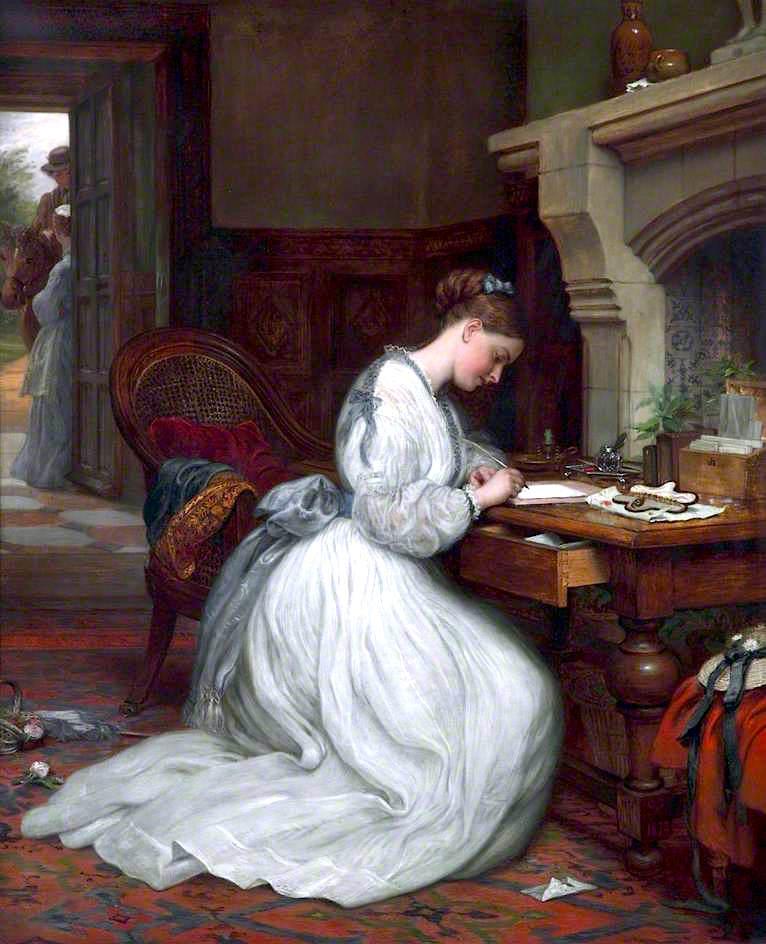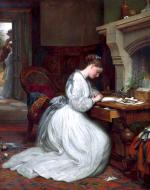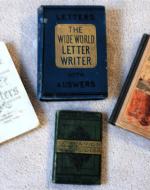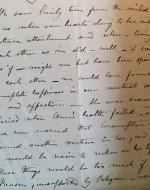Created by Aaron Swartz on Tue, 11/03/2020 - 11:46
Description:
With the revolution provided by the Penny Post in 1840, letter writing became a crucial aspect of Victorian life. It allowed for people to remain in contact over long distances and long stretches of time without having to travel very far to see them in person. The Brontës, isolated in Haworth and largely contained within their home, utilized letter writing as one of the sole avenues available to them to contact the outside world, and letter writing’s importance in both their daily lives and in the Victorian era as a whole is reflected in their novels, all of which feature letter writing to a great degree.
Yes or No? by Charles West Cope, 1872.(Walker Art Gallery, Liverpool)
In this image, we see a young woman going about the process of answering a letter, presumably one which required her to — as the title suggests — answer "yes" or "no." We can see that the woman depicted is solely focused on the letter in front of her, which is to be written on a fresh sheet of white paper with the delicate pen held in her hand. Next to the paper we can see various tools for letter writing, as well as a drawer which is half open revealing more paper, presumably to be used for other letters. Near the back of the desk we can see a case containing envelopes and sheets of paper of various sizes, showing how much thought and preparation went into answering a simple letter in the Victorian era. In the Brontës' lives, we can imagine much the same process taking place whenever they received or answered letters, the entire process given major importance, especially for people isolated from much of the world, as the Brontës were. We can imagine them in place of this woman, staring at the blank sheet of paper with the same intense concentration.
Four Victorian Letter-Writing Manuals. Photograph by Michael Marx, 2010
http://www.Victorianweb.org/technology/letters/5.html
With the rise of the Penny Post came a huge array of letter writing paraphernalia: items like writing desks, stamp boxes, letter holders, and letter writing manuals. These manuals included detailed instructions on how to write a wide variety of letters, from condolences to job applications, all of which had “acceptable” models for being written. The guidelines for how one should write a letter were incredibly specific with stress being placed upon everything from paper quality, to handwriting, to the formation of individual sentences. Considering the amount of social power a person’s letter writing ability might have, it’s no surprise that letter writing manuals like these proliferated in the Victorian era. We can see this social importance reflected in Anne’s Tenant of Wildfell Hall where Gilbert Markham is desperate to merely read letters written by Helen Graham’s hand, as they provide a link to her physical being which was much more precious than it would be today.
Letter Written By Charlotte Brontë About Emily's Death, 1849 (University of Cambridge Museum and Botanical Gardens)
https://www.museums.cam.ac.uk/blog/2018/07/27/her-story-charlotte-brontes-letters/
Here we see a letter written by Charlotte herself about one sister — Emily’s — death, and another sister — Anne’s — subsequent decline in health. Though it’s not visible in the image, this letter was written on black edged mourning paper to signify it concerned death. Charlotte’s letter is remarkably well composed throughout, though her grief begins to break through when she discusses her sisters respective conditions, which reemphasizes how important letter writing etiquette was in the Victorian Era. Even discussing the death and sickness of her close kin, Charlotte does her best to remain removed, elegant, and composed in her writing. Her handwriting and sentence structure are as impeccable as possible because that was what was expected. We can draw literary parallels to how death and mourning letters appear repeatedly in the Brontës novels, as death was something they all reckoned with throughout their lives. The poise and care given to discussing Emily’s death helps inform how Charlotte discusses the death of Helen Burns in Jane Eyre and her sister Emily discusses deaths like that of Hindley in Wuthering Heights.




